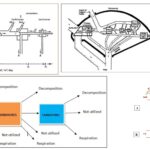Neuroscience 6 Views 1 Answers
Sourav PanLv 9September 23, 2024
What are the steps in the scientific process? Describe each one.
What are the steps in the scientific process? Describe each one.
Please login to save the post
Please login to submit an answer.
Sourav PanLv 9May 15, 2025
The scientific process is a systematic approach that researchers use to investigate phenomena, acquire new knowledge, or correct and integrate previous knowledge. It consists of several essential steps, each playing a crucial role in the development of scientific understanding. The steps in the scientific process include:
- Observation:
- Description: This initial step involves making careful and systematic observations about a phenomenon or a specific question of interest. Observations can be derived from experiments, clinical cases, or natural occurrences.
- Purpose: Observations help identify patterns, anomalies, or specific behaviors that prompt further investigation and the formulation of hypotheses.
- Hypothesis Formation:
- Description: Based on the observations, researchers propose a hypothesis, which is a testable and falsifiable statement that predicts the relationship between variables or explains a phenomenon.
- Purpose: The hypothesis serves as a guiding framework for the research, providing a clear focus for experimentation and data collection.
- Experimentation:
- Description: Researchers design and conduct experiments to test the hypothesis. This involves manipulating one or more independent variables while controlling for other factors to observe the effects on dependent variables.
- Purpose: Experiments provide empirical data that can support or refute the hypothesis, allowing researchers to draw conclusions based on evidence.
- Replication:
- Description: Replication involves repeating the experiments to verify the results. This can be done by the original researchers or by independent scientists to ensure that the findings are consistent and reliable.
- Purpose: Replication helps confirm the validity of the results and reduces the likelihood that the findings were due to chance or experimental error.
- Interpretation:
- Description: After collecting and analyzing the data, researchers interpret the results in the context of the original hypothesis. They assess whether the data supports or contradicts the hypothesis and consider alternative explanations.
- Purpose: Interpretation allows researchers to draw meaningful conclusions from the data, contributing to the understanding of the phenomenon being studied.
- Verification:
- Description: Verification involves confirming that the observations and results are robust and reproducible. This step may include peer review and publication of the findings in scientific journals.
- Purpose: Successful verification establishes the findings as accepted scientific knowledge, while negative verification may lead to new interpretations or further investigation.
- Communication:
- Description: Researchers share their findings with the scientific community and the public through publications, presentations, and discussions. This step is crucial for advancing knowledge and fostering collaboration.
- Purpose: Communication allows others to evaluate, replicate, and build upon the research, contributing to the collective understanding of the field.
These steps form a cyclical process, as new observations and questions can arise from the conclusions drawn, leading to further research and exploration
0
0 likes
- Share on Facebook
- Share on Twitter
- Share on LinkedIn
0 found this helpful out of 0 votes
Helpful: 0%
Helpful: 0%
Was this page helpful?




